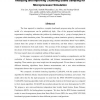Free Online Productivity Tools
i2Speak
i2Symbol
i2OCR
iTex2Img
iWeb2Print
iWeb2Shot
i2Type
iPdf2Split
iPdf2Merge
i2Bopomofo
i2Arabic
i2Style
i2Image
i2PDF
iLatex2Rtf
Sci2ools
112
click to vote
SBACPAD
2005
IEEE
2005
IEEE
Analyzing and Improving Clustering Based Sampling for Microprocessor Simulation
The time required to simulate a complete benchmark program using the cycle-accurate model of a microprocessor can be prohibitively high. One of the proposed methodologies, representative sampling, addresses this problem by simulating only a group of unique phases in a program called simulation points. The methodology selects simulation points by characterizing each fixed chunk of instructions in the program using a feature called Basic Block Vector (BBV), clusters them into groups of similar chunks of instructions, and then selects a representative chunk of instructions from each cluster. The accuracy of this technique is highly dependent on the choice of the feature, clustering technique, and the distance measurement used for clustering. Previous research does not completely address all these aspects. In this paper, we propose a set of statistical metrics for making a comprehensive and fair evaluation of features, clustering algorithms, and distance measurements in representative sam...
Clustering Algorithm | Computer Architecture | Distance Measurements | Hardware | Representative Sampling | SBACPAD 2005 |
Related Content
| Added | 25 Jun 2010 |
| Updated | 25 Jun 2010 |
| Type | Conference |
| Year | 2005 |
| Where | sbacpad |
| Authors | Yue Luo, Ajay Joshi, Aashish Phansalkar, Lizy Kurian John, Joydeep Ghosh |
Comments (0)

